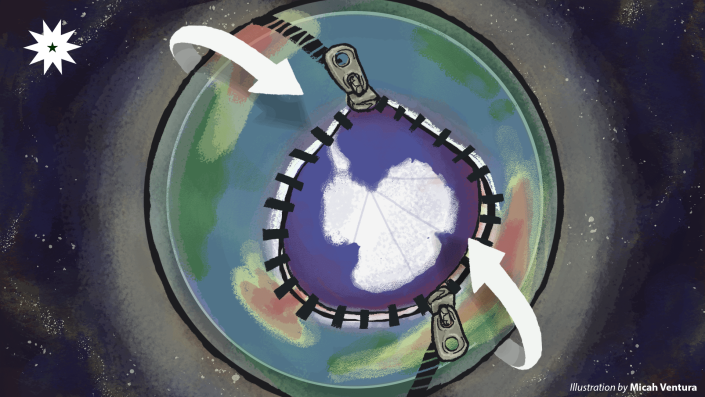In recent years, ozone layer depletion—a talking point for the past 50 years—has been put on the backburner amid seemingly more pressing environmental concerns. Although great strides have already been made in combating this issue, have these past efforts been sufficient to warrant its departure from the forefront of the world stage?
The ozone layer is a portion of the Earth’s stratosphere populated by high concentrations of ozone, a compound generated from the exposure of oxygen to ultraviolet (UV) light. This region can be credited for absorbing much of the potentially-damaging UV radiation that attempts to penetrate the atmosphere. Thus, with the thinning of the ozone layer comes the threat of amplifying UV radiation’s numerous adverse effects ranging from skin cancer and cataracts to premature aging and immune suppression.

Trouble afoot
As Dr. Martyn Chipperfield, a professor at the University of Leeds, recounts, the first signs of trouble were identified in the 70s. Concerns were initially raised about ozone loss caused by the prevalent use of chlorofluorocarbons (CFCs), which are gaseous organic compounds composed of chlorine, fluorine, and carbon. These CFCs were commonly found in refrigerants due to their high heat capacity and in aerosol propellants to help produce a spraying effect. Even though reservations had already existed then, Chipperfield notes that “at the time, the models that we used to predict what would happen were inadequate,” thereby causing the extent of the present damage to have been severely underestimated.
When the mid-80s rolled around, the situation took a dire turn for the worse when the discovery of an ozone hole over the Antarctic suddenly made headlines. The frigid climate of the Antarctic turned out to be the perfect breeding ground for polar stratospheric clouds, which further exacerbated the ongoing ozone depletion caused by CFCs.
With the urgency of the issue becoming irrefutable, research efforts and corrective measures quickly escalated. “It was transformed overnight from a…situation assuming we knew what was going on to one where we realized we didn’t,” Chipperfield recalls.
Cause to cooperate
Theories abounded regarding the origins of the ozone hole, sparking broader debates about whether the hole was natural or man-made. Chipperfield mentions how it took “a year or two” for CFCs to be definitively identified as the cause of the hole. However, Professor Marina Friedel, a climate scientist at the Swiss Federal Institute of Technology in Zürich, points out that even before this link had been established, some countries had already begun banning CFC emissions. In 1985, the same year the ozone hole was discovered, countries began signing the Vienna Convention for the Protection of the Ozone Layer, a multilateral treaty calling for greater production and exchange of research on climate and atmosphere.
It was the 1987 Montreal Protocol that sought to combat the ozone hole in earnest. The treaty was highly effective, in no small part due to how cleverly it was crafted. Chipperfield cites how the treaty first required relatively small cuts to CFC production—cuts that gradually became larger over the course of successive treaty revisions. The clear impact of CFCs on the ozone layer also drove policymakers and industries to cooperate willingly.
There have been very few violations of the protocol. Chipperfield recalls that, in 2018, scientists monitoring atmospheric gas concentration levels found that a specific type of CFC was not reducing in concentration as predicted, and further research pointed to the source being China. Soon after this research was published, the additional emissions stopped.
Chipperfield takes this as a sign of the Montreal Protocol’s success: “we can observe the atmosphere so well that we can spot where the protocol is not being followed.” The Montreal Protocol has since expanded to cover other gasses, largely ones that were being used in place of CFCs, and the vast majority of chlorine gasses that destroy ozone have been controlled.
Right back on track
Ozone depletion swept the front page of newspapers in the 80s. As global warming and the ozone layer entered the zeitgeist, climate scientists and activists gave everything to avoid catastrophic consequences. Fair enough, their efforts paid off in the end, especially after the establishment of the Montreal Protocol.
Currently, efforts are still being made to rebuild the once-depleting ozone layer. However, due to the long atmospheric residence times of CFCs, the process of recovery is not completed overnight. The flipside, nonetheless, is that the Antarctic ozone is anticipated to be fully healed by the year 2060, provided that “all parties continue to stick to the regulations of the Montreal Protocol,” Friedel notes.
Thus, it is without a doubt that efforts to heal the ozone layer have achieved a feat over the decades as they champion the environment. This example of a unified global effort only paves the way for hope in overcoming other pressing environmental issues such as climate change, coral bleaching, unsustainable farming practices, and such.
But even after extensive measures have been taken to reduce carbon emissions, the question lies in whether the ozone layer will remain fully healed or if human activity will outweigh and interrupt the recovery process once again.
